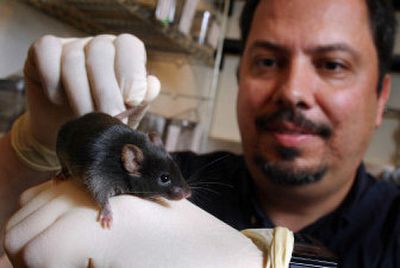Millions of mice mutate for science

SAN FRANCISCO – They’re being bred now by the millions, the mutants, created to carry the ghastliest of diseases for the benefit of the human race.
Since researchers published the mouse’s entire genetic makeup in map form three years ago, increasingly exotic rodents are being created with relative ease.
There’s the Schwarzenegger mouse – injected with muscle-building genes. The marathon mouse, which never seems to tire. Researchers recently engineered some mice to be extremely addicted to nicotine, and others to be immune to scrapie, a close cousin to the brain-wasting mad cow disease. And scientists are in hot pursuit of a Methuselah mouse, able to cheat death long after its natural brethren meet their maker.
Millions of these and other mutant mice are routinely created now, by injecting disease-causing genes or “knocking out” genes in mouse embryos. Their decreasing cost and increasing availability is helping researchers in pursuit of all manner of disease cures.
Top researchers in the Parkinson’s disease field, for example, were more excited by the dopamine-free “knock-out” mouse that Duke University researchers invented than the actual study they unveiled this week, which suggests that the club drug Ecstasy reversed Parkinson’s-like effects in these particular bio-engineered mice.
Researchers first genetically engineered a mouse in 1980. But until recently, such creations were mostly scientific novelties.
That changed drastically after President Clinton announced the mapping of the human genome in 2000. That’s because mice and men are nearly genetically identical, each possessing just a few hundred different genes out of a possible 25,000 or so. Cancer in mice is a lot like human cancer, for instance. Mice have become powerful, living research tools.
The number of mutant research mice has grown so dramatically in recent years that companies are now profiting by housing and breeding scientists’ creations.
The repository with the country’s widest selection of mutant mice is the nonprofit Jackson Laboratory in Bar Harbor, Maine, where most researchers who genetically engineer mice with government money are required to send some of their mice.
The lab boasts a collection of nearly 3,000 different mutant mice types and shipped 2 million animals to U.S. researchers last year.
The Jackson Laboratory’s main focus is cancer research, but the mice business accounts for $60 million annually, spokeswoman Joyce Peterson says.
Nearly all the genetically engineered mice in circulation today have but one gene added, subtracted or altered. The problem with that model is that many diseases such as diabetes and cancer are caused by multiple gene malfunctions.
“Eventually, that’s where engineered mice are going,” said Mendell Rimer, a University of Texas neuroscientist who tends to about 500 mice in his Austin lab. “That’s a more realistic disease model.”
Rimer spent 2 1/2 half years engineering mice with muscles that lose connection to their nerve cells. He’s done this by splicing into mice a cancer gene which creates a protein that “disassembles” the connections. But he’s also taken his work one step further than the usual cut-and-paste work.
Rimer is able to turn on the mutant gene by feeding the genetically engineered mouse an antibiotic. He can turn it off by stopping the antibiotic treatment. This way, he can observe the progression and regression of the mutation he made, giving him unparalleled insight into how nerves communicate with the muscle.